

Catch Fish with
Mike Ladle
Information Page
SEA FISHING
For anyone unfamiliar with the site always check the FRESHWATER, SALTWATER and TACK-TICS pages. The Saltwater page now extends back as a record of over several years of (mostly) sea fishing and may be a useful guide as to when to fish. The Freshwater stuff is also up to date now. I keep adding to both. These pages are effectively my diary and the latest will usually be about fishing in the previous day or two. As you see I also add the odd piece from my friends and correspondents if I've not been doing much. The Tactics pages which are chiefly 'how I do it' plus a bit of science are also updated regularly and (I think) worth a read (the earlier ones are mostly tackle and 'how to do it' stuff).
Catching bass.
Bait fishing.
Having waxed enthusiastic about lure fishing and fly fishing for bass I suppose that I ought to give equal consideration to the best chance of catching big bass - which I am pretty sure is by using bait. I have to say that I'm not talking about monster bass, because finding these is largely a matter of chance. Of course I'm well aware that lures also catch big fish but, in terms of probabilities, bait usually wins hands down. What I consider big is anything over about 3.5kg or roughly 68cm in length.
For the moment we can ignore the where, when and how of placing the baited hook because this will differ for every venue. Even if I'd fished every inch of coastline on every tide, time and weather pattern (and I haven't) it would need a book bigger than the Encyclopaedia Brittanica to hold the information. By far the most important elements of fishing are firstly, the nature of the bait and secondly, what to do should you get a bite. The bait is a relatively easy thing to decide. My good friend Alan Vaughan has caught a lot of big bass on baits so, his views give me a good starting point. In our book "Hooked on Bass", we listed the sort of things that bass might eat. To summarise:- the ones that can be used for bait include things like lugworms, ragworms, crabs, pieces of fish, small whole fish, prawns, squid/cuttlefish, razorfish, clams, maggots, marine 'woodlice' and various bits of household food waste.
Alan sums up the situation by saying - "One thing is constant: to catch decent sized bass regularly, with few exceptions whatever bait you use should be a big one." I totally agree with this. So first things first - how big is BIG? For their size bass have large mouths and even schoolies of a couple of pounds will easily engulf a big prawn or a bunch of worms so, to reduce the chances of a small specimen getting to your bait first, you may need to bulk up your offering to something like the head and shoulders of a fair sized mackerel, a couple of calamari, a large edible crab or several shore crabs. Of those listed above only fish, squid/cuttlefish, crabs and food waste are readily obtainable AND easily make up a decent sized bait.
The head and shoulders of a decent mackerel makes a good sized bait.
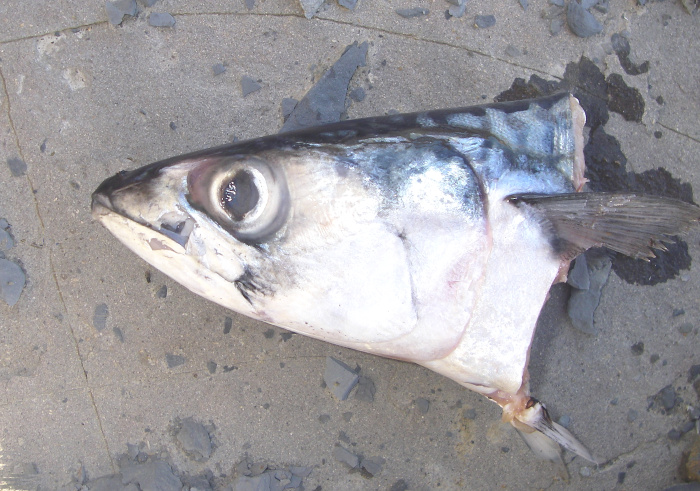
Even better is a whole, live (or dead) mackerel.
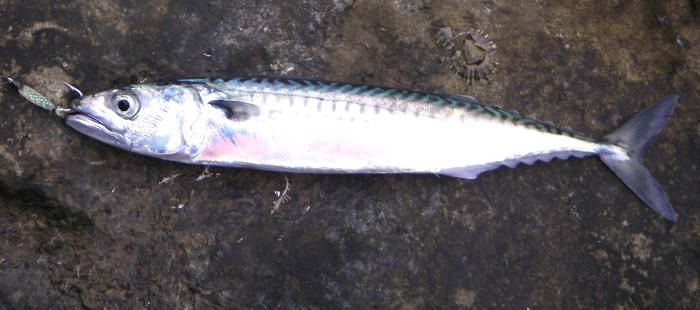
I've quoted mackerel as an example of 'big' baits because they are the things I've personally used most. However, I've caught good fish on crab and squid as well. I'd be perfectly happy using almost any fish that I found under a rock on the shore - blennies, rocklings, butterfish, eels, whatever! Similarly, almost any fish of around 500g - give or take - that you catch by fly, spinning or bait fishing, for example pouting, poor cod, pollack, scad, wrasse and so on, is likely to be a good bass attractor. Bass certainly eat all of them. Failing these options a couple of squid or even a kipper or a chunk of chicken from the freezer could be effective. Having said that, it comes down to being confident in your bait, which is less easy if you have never caught anything on it. The best bait may vary from place to place and time to time. So, in the crab peeling season, in an area where crabs are abundant (not where I generally fish), I expect I'd be collecting crabs and using them (buying them would go against the grain - it's hard enough for me to invest a couple of quid in a big bag of pilchards - which will last me for months). Squid/cuttle is also a pretty good all-round attractor, keeps well in the freezer and certainly catches fish.
Launce - sandeels are a very popular choice in the Channel Islands and the South-West.
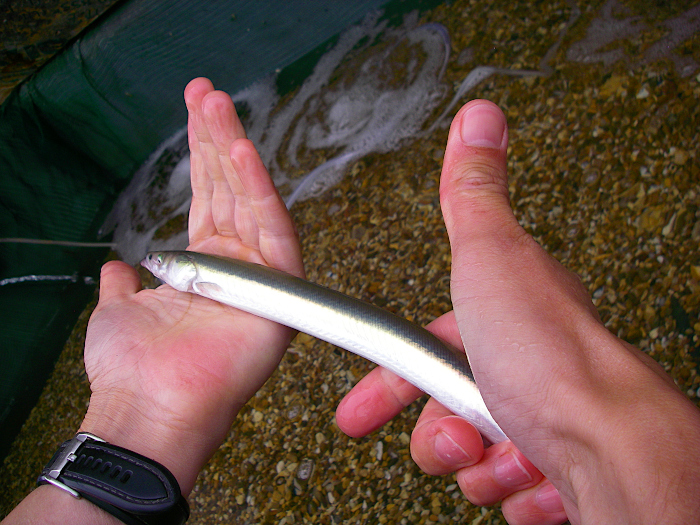
A young pollack - not the liveliest bait but the bass like them.
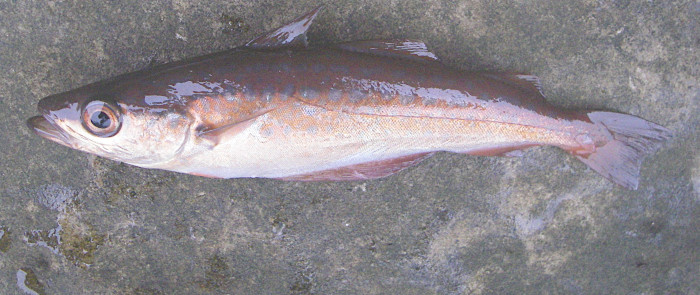
Scad - bite well at dusk and dawn and make good bass baits.
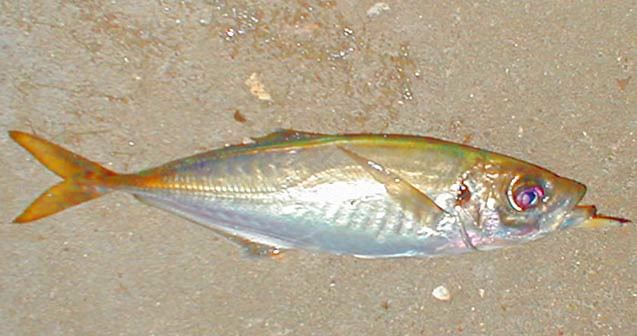
Having chosen your bait you then have to put it where a good bass might find it. These fish have a pretty good sense of smell/taste and they certainly have excellent eyesight. The conditions which are usually regarded as appropriate for bait fishing; a bit of movement, coloured water, night-time or particularly first and last light, generally apply. However, these are by no means the only times it is worth fishing a bait. I've caught lots of good fish in broad daylight and in flat calm, clear conditions. The fish will often be incredibly close to the shore (feet rather than yards) so try to avoid scaring them; stand well back from the water, try and arrange, if you can, to have a dark background (cliff etc), keep low and above all minimise your movement and rod waving. I know it sounds strange to a sea angler but I've scared more good fish than I care to think about.
My pal Nigel lands a nice bass, free-lined from very shallow water in a bit of a surf.
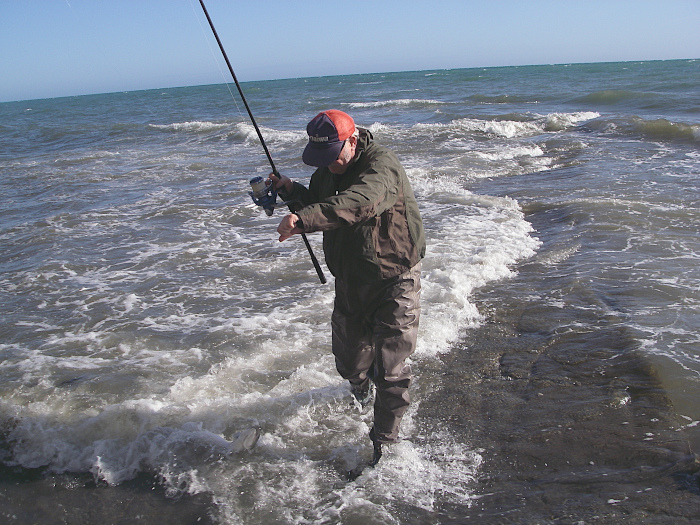
Bass feed in weedy, murk close to the edge.
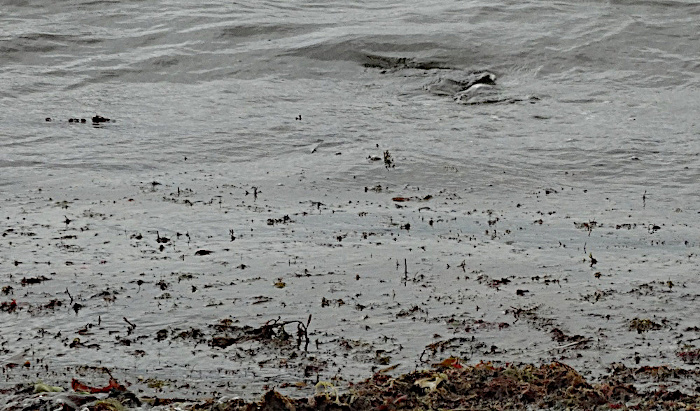
...and they take baits well in the dark.
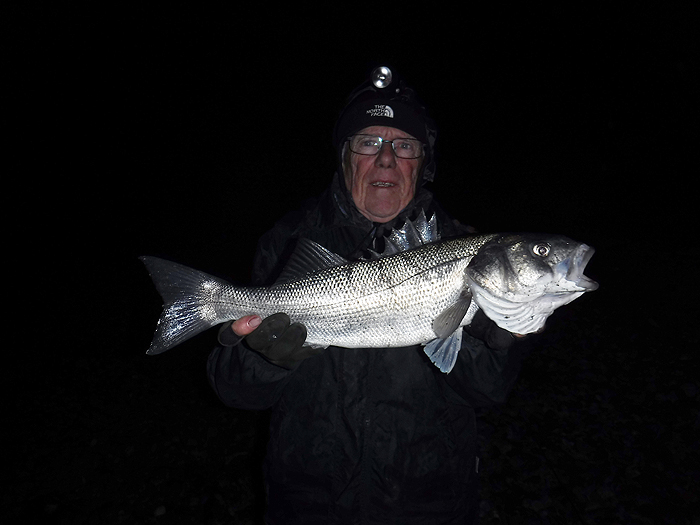
...but - calm, clear, bright and I sit quietly waiting for some water to arrive with the free-lined bait just out of shot on the left.
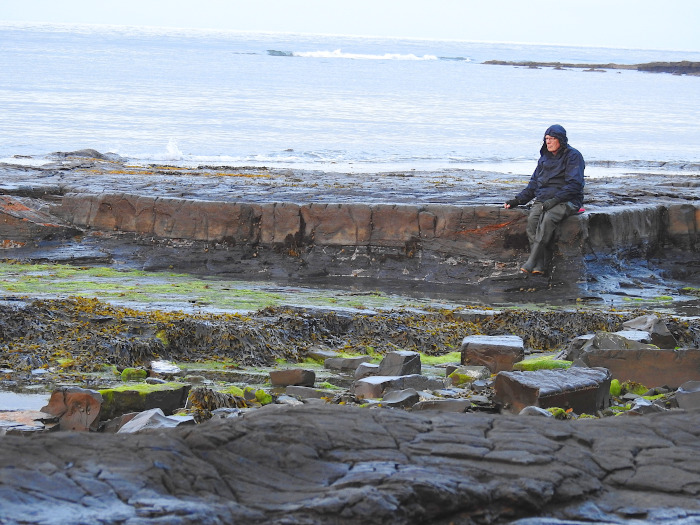
When it comes to 'how to do it', it is your choice. I would just say that, if possible, minimise the amount of lead you use - I think that none at all is good - which is easier when the fish are close in. Of course it may be necessary to use some weight to hold the bait down if there's surf or tidal currents where you fish. Every angler will have their own preferred approach and tackle set up, but for the way I fish I try to avoid ANY resistance to a taking bass. To quote from my angling 'hero' the late Richard Walker - "Do not ask yourself 'Do I need the float, or lead which I have on my tackle?' but 'What is the simplest tackle with which I can catch this fish?' Quite often the answer to his question will be simply 'A baited hook on the end of the line.'
These days circle hooks are 'the business'. They are not equally effective for every species but for bass, wrasse, pike, perch and chub I have shown that they are very good. Of course you will ALWAYS get the occasional fish deeply hooked whatever gear you use but, here's what scientists Cooke and Suski have to say on the subject after researching the literature on recreational fishing for striped bass and some other species - "...the mortality rates (of fish caught) were consistently lower for circle hooks than J-style hooks. In addition, (fish landed on) circle hooks were more frequently hooked in the jaw, and less frequently hooked in the gut than conventional hook types. There is no doubt that ........ capture efficiency remains high and injury and mortality rates are drastically reduced. Personally, I am quite sure that, if these hooks work for striped bass they will be equally suitable for Dicentrarchus labrax.
Ballan wrasse on a paternostered circle hook baited with worm.
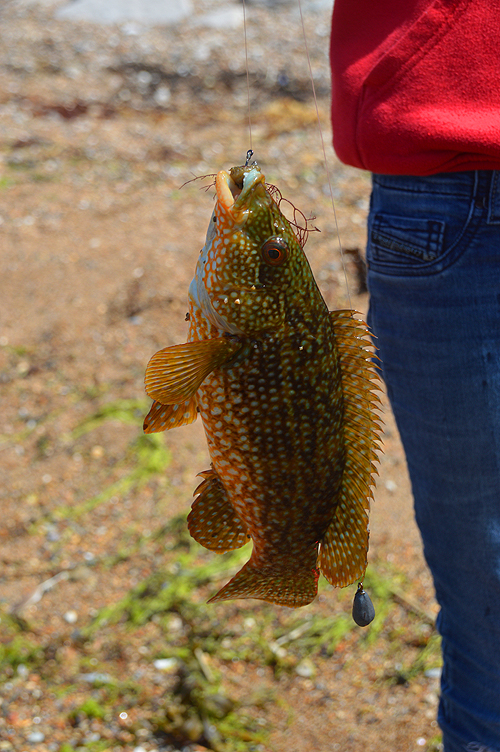
Pike on a livebait.
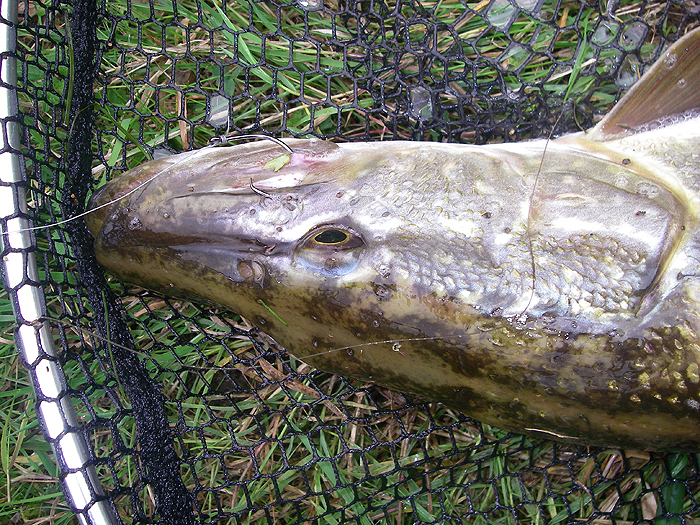
... and perch. Note the wire anti-pike trace on perch and chub pictures.
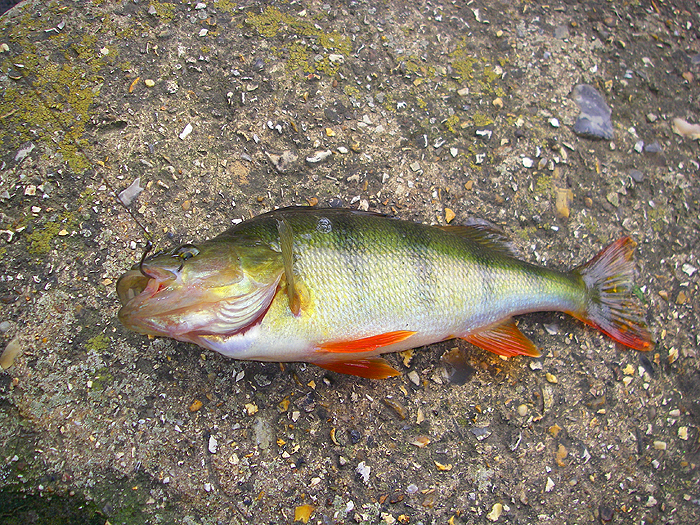
... and chub when using natural fish baits.
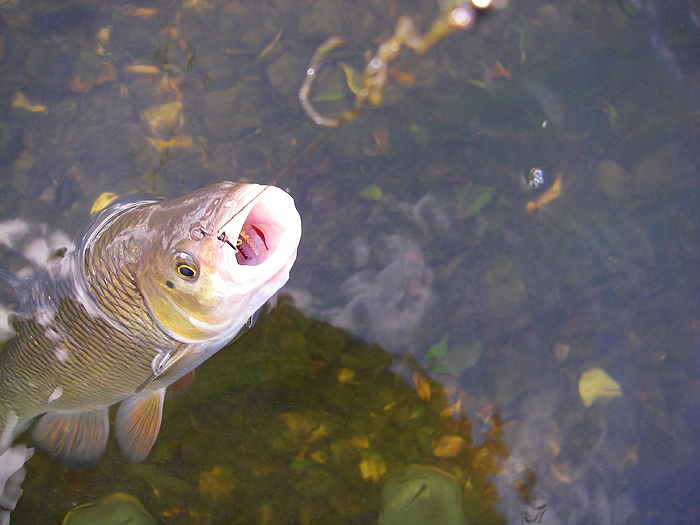
So, what's the score when it comes to using circle hooks for bass? I reckon any rod (e.g. my spinning rods) capable of gently lobbing or, for bigger baits, lowering up to about 500g of bait will be OK. I generally use a-metre-or-so of 9kg, clear, Amnesia mono on the end of my braided line and tie a 6/0-8/0 circle hook (depending on the nature of the bait) to the end of the nylon. The mono is tied round the shank of the hook, after passing it through the front of the eye; it has been shown that this can improve the hook-up rate by as much as 30%. The baits are always hooked so that the maximum amount of point and bend is exposed (sort of hair rigging without the hair) - tip of the thin end for fillets, both lips for head and shoulders, upper lip only for livebaits.
Mackerel fillet 'hair-rigged'.
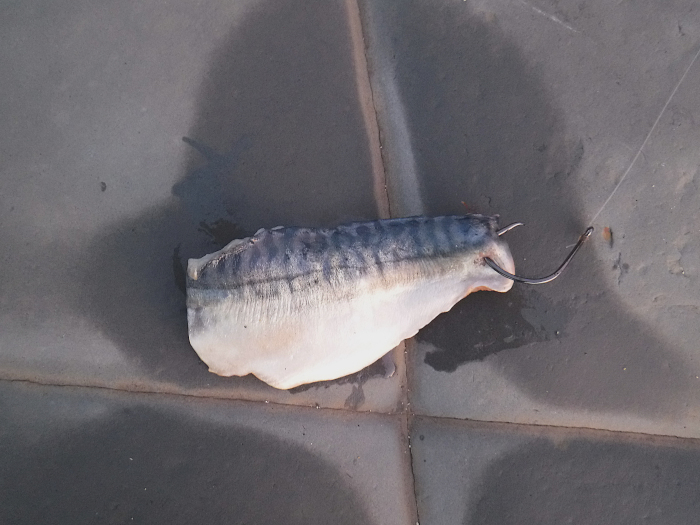
Head and shoulders lip-hooked. Note how the nylon enters the front of the hook-eye.
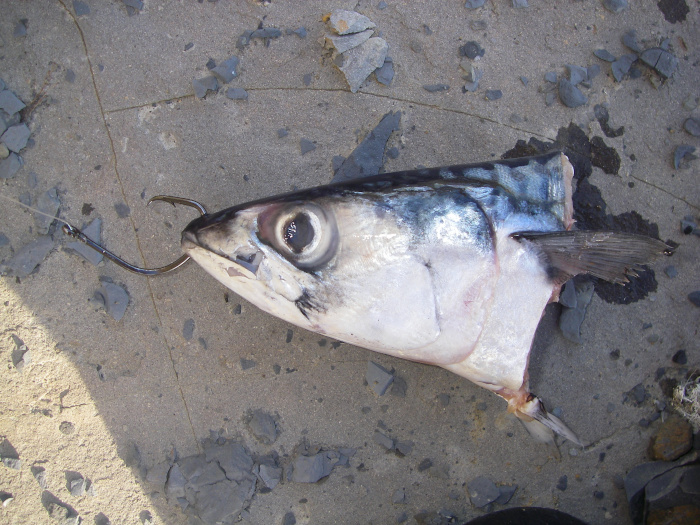
Livebait lip hooked.
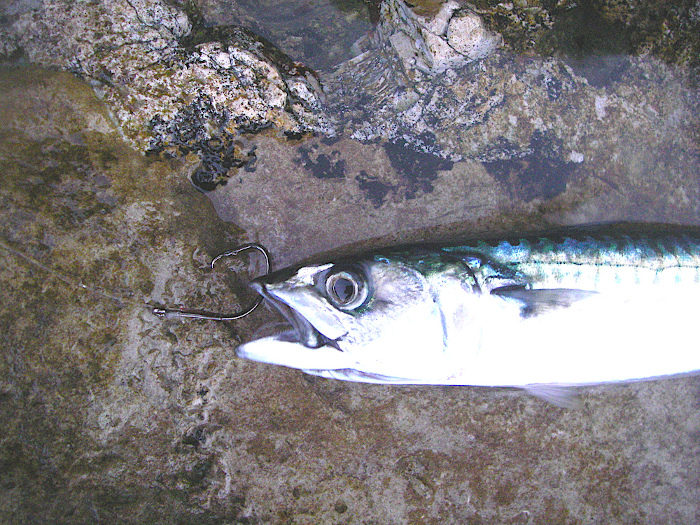
Just to finish off, a few words about what to do when you get a bite. The 'best practice' may vary a bit according to the nature and size of the bait and the type of fish. Remember that I'm usually fishing with just a hook and a bait although some of my pals and I have tried using a float with livebaits. In my experience the float is irrelevant if you are using mackerel livebaits, but for some other baits, such as pollack, which may go to ground, it could be essential. Anyway, live or dead bait, when I get a take and given minimal resistance the bass almost invariably runs hard and fast. If there is room (snags permitting) I simply let it go for a fair distance, say 20 metres. Then I step towards and/or drop the rod towards the fish to avoid a tight line as I close the bale arm. After this simply hold the rod firmly until the line tightens and the bass hooks itself. The rest is up to you and the knots that you have tied.
Free-lining for bass at dusk. See the line sloping down to the bait, in shallow water only a couple of metres out.
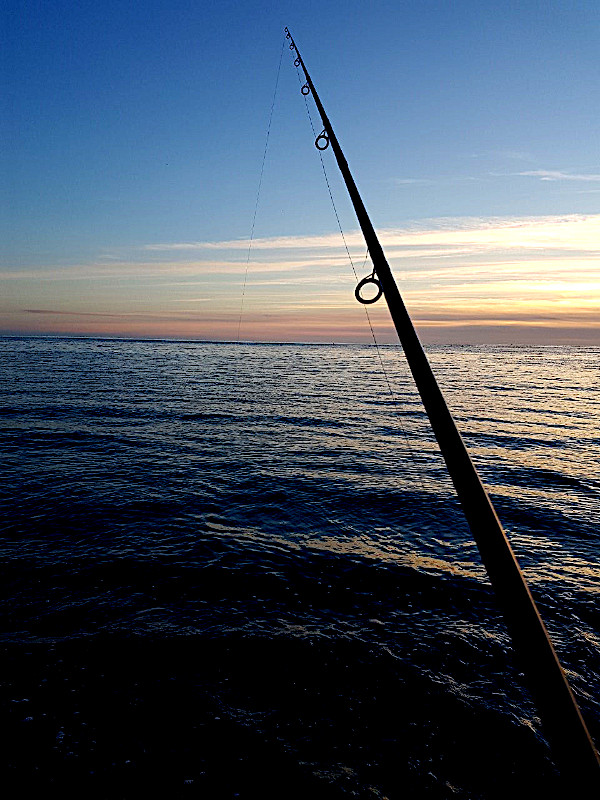
Grandson Ben pleased with a nice fish on deadbait (his first).
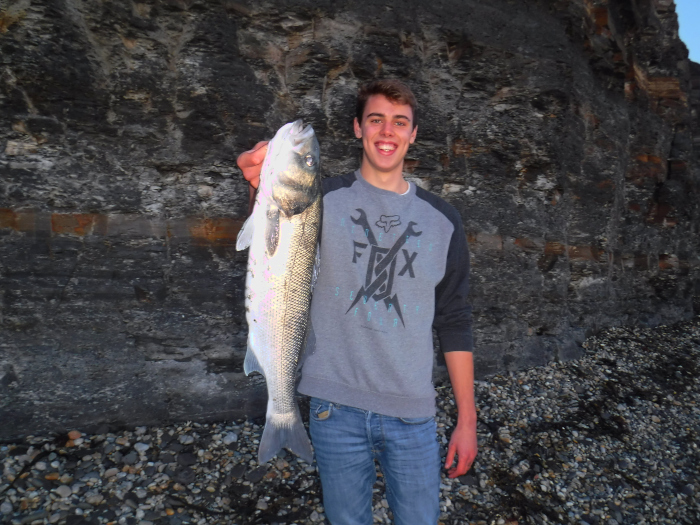
Early attempt with scad livebait using corks as a float.
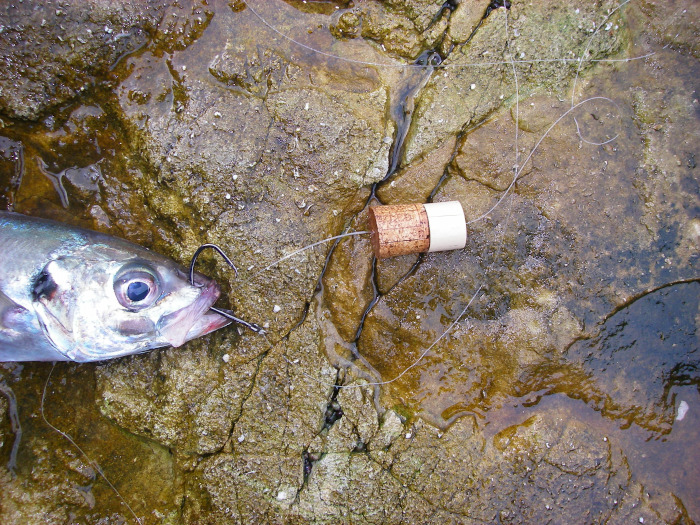
...and a good bass. This one actually took a sizeable mackerel on the same set up as in the previous picture.
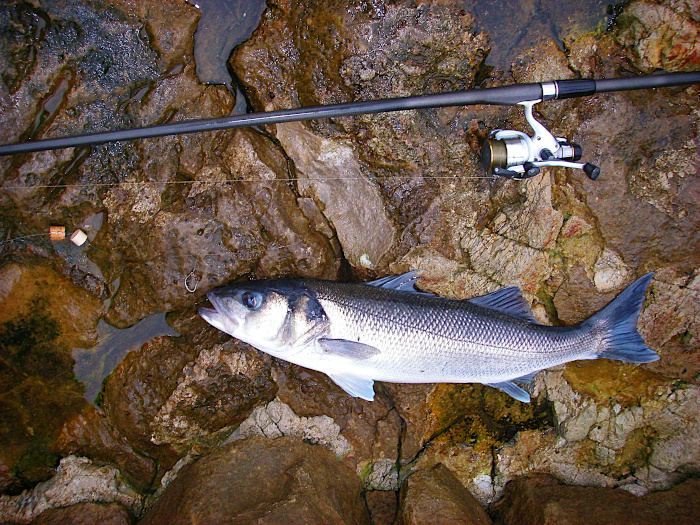
If you have any comments or questions about fish, methods, tactics or 'what have you.'get in touch with me by sending an E-MAIL to - docladle@hotmail.com
– PLEASE TELL YOUR TWITTER, FACEBOOK, EMAIL FRIENDS ABOUT THESE BOOKS.
NEW BOOK
"Fishing for Ghosts - Successful Mullet Angling"
written with David Rigden IT'S AVAILABLE FROM -ALSO THE NEW BOOK
“The Second Wave”
Written with Steve Pitts this is a SEQUEL TO THE BESTSELLER "Operation Sea Angler" IT'S AVAILABLE ON PAPER OR FOR YOUR KINDLE FROM -